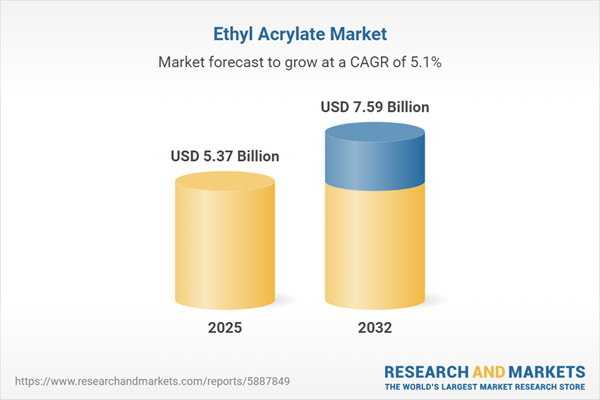Speak directly to the analyst to clarify any post sales queries you may have.
Senior decision-makers in the chemicals and manufacturing sectors increasingly recognize ethyl acrylate as a strategic input for streamlining high-performance applications, ensuring regulatory alignment, and adapting to evolving market demands. Sophisticated market intelligence is key to navigating this fast-changing landscape.
Market Snapshot: Strategic Analysis of the Ethyl Acrylate Market
The global ethyl acrylate market is projected to expand from USD 5.11 billion in 2024 to USD 5.37 billion in 2025, with expectations of reaching USD 7.59 billion by 2032. This reflects a steady CAGR of 5.05%.
Market progression is shaped by the adoption of digital manufacturing solutions, intensified sustainability programs, and enhancements in supply chain processes. Producers respond to complex regulatory trends by modernizing workflows, integrating compliance capabilities, and prioritizing quality. These dynamics demand that organizations implement adaptive management strategies to retain competitiveness and optimize resource allocation amid shifting operational landscapes.Scope & Segmentation of the Ethyl Acrylate Market
- Applications: Utilized across acrylic resins, industrial adhesives, specialty coatings, engineered plastics, and textile finishing, ethyl acrylate promotes durable end products while ensuring alignment with current compliance practices.
- End Use Industries: Automotive, construction, electronics, packaging, and textiles capitalize on ethyl acrylate to address diverse supply chain and performance needs within their respective domains.
- Product Grades: High-purity, industrial, and technical grades allow producers to address distinct sector requirements and ensure adaptability in a wide array of manufacturing contexts.
- Distribution Channels: Sourced both through direct procurement and established distributor networks, these flexible channels allow for alignment with shifting supply requirements and localized regulations.
- Product Forms: Offered as emulsions, liquids, and solutions, ethyl acrylate accommodates varied production specifications, from mass manufacturing to bespoke formulations in specialty sectors.
- Regions: Activity spans North America, South America, Europe, Middle East & Africa, and Asia-Pacific. Leading countries—including the United States, Germany, China, India, Japan, and Australia—shape unique procurement and compliance practices influenced by their respective policies and industry frameworks.
- Key Companies Analyzed: BASF SE, Dow Inc., Evonik Industries AG, Eastman Chemical Company, Arkema S.A., Huntsman Corporation, Mitsubishi Chemical Holdings Corporation, Sumitomo Chemical Co., Ltd., Saudi Basic Industries Corporation, and China Petroleum & Chemical Corporation are at the forefront of technology adoption and market advancement.
Key Takeaways for Senior Decision-Makers
- Ethyl acrylate enhances manufacturers’ operational agility, supporting rapid realignment with evolving customer and industry requirements.
- Sustainability objectives can be advanced through ecofriendly catalyst choices and reduction of conventional solvent use, thus aligning with tightening regulatory standards across production and distribution.
- Digital transformation—such as real-time manufacturing monitoring and robust quality protocols—delivers transparency, supports efficient scaling, and improves risk mitigation.
- Bio-based feedstocks broaden product portfolio diversity and align with elevated sustainability and continuity requirements.
- Modernizing supply chain management and proactive risk assessment enhance both responsiveness and resilience in the face of market or regulatory volatility.
- Flexible sourcing and adaptable product portfolios allow for rapid response to market shifts and evolving buyer preferences without sacrificing compliance or consistency.
Tariff Impact: Navigating Supply Chain Shifts in 2025
Current U.S. tariff actions have pushed input costs upward for ethyl acrylate importers, resulting in restructured supplier networks and increased emphasis on bolstering domestic production. This transition is fostering deeper regional collaborations and spurring improvements in supply chain resilience. The adoption of advanced catalysts and modern production technologies plays a critical role in stabilizing costs and fortifying sustained supply even as market pressures and regulations change.
Methodology & Data Sources
This research reflects a synthesis of respected industry publications, relevant regulatory filings, and direct market stakeholder input. Findings are confirmed through cross-analysis and scenario assessment, yielding actionable recommendations for business leaders and procurement teams.
Why This Report Matters for Market Leadership
- Enables targeted regulatory monitoring and identification of emerging opportunities, helping leaders prioritize growth investments in strategic segments.
- Strengthens supply chain flexibility and responsiveness through insights into digital adoption and best operational practices.
- Empowers confident, data-driven decision-making, supporting robust risk protocols and promoting continuous innovation for long-term market positioning.
Conclusion
Grounded insights into the ethyl acrylate market empower organizations to optimize operations, comply with regulatory requirements, and reinforce resilience as the industrial environment continues to advance.
Additional Product Information:
- Purchase of this report includes 1 year online access with quarterly updates.
- This report can be updated on request. Please contact our Customer Experience team using the Ask a Question widget on our website.
Table of Contents
3. Executive Summary
4. Market Overview
7. Cumulative Impact of Artificial Intelligence 2025
List of Figures
Companies Mentioned
The companies profiled in this Ethyl Acrylate market report include:- BASF SE
- Dow Inc.
- Evonik Industries AG
- Eastman Chemical Company
- Arkema S.A.
- Huntsman Corporation
- Mitsubishi Chemical Holdings Corporation
- Sumitomo Chemical Co., Ltd.
- Saudi Basic Industries Corporation
- China Petroleum & Chemical Corporation
Table Information
| Report Attribute | Details |
|---|---|
| No. of Pages | 180 |
| Published | November 2025 |
| Forecast Period | 2025 - 2032 |
| Estimated Market Value ( USD | $ 5.37 Billion |
| Forecasted Market Value ( USD | $ 7.59 Billion |
| Compound Annual Growth Rate | 5.0% |
| Regions Covered | Global |
| No. of Companies Mentioned | 11 |









